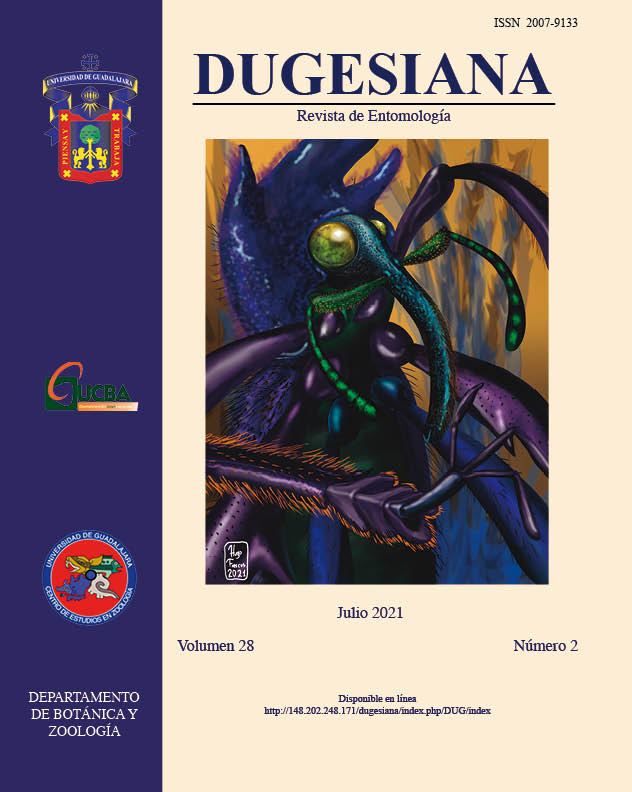FIRST RECORD OF A MASS SWARMING BEHAVIOR OF CHAULIOGNATHUS VESTITUS CHAMPION, 1915 (COLEOPTERA: CANTHARIDAE) WITH
DOI:
https://doi.org/10.32870/dugesiana.v28i2.7156Abstract
In this work we document a case of mass swarming of the Mexican soldier beetle Chauliognathus vestitus Champion, 1915 from El Terrero locality, within the Sierra de Manantlan Biosphere Reserve, in Colima, Mexico. Two other species of soldier beetles —Chauliognathus togatus Waterhouse, 1878 and Chauliognathus sp.— were observed at El Terrero, coexisting with C. vestitus, but their numbers were considerably lower. Our observations represent, to our knowledge, the first record of mass flying behavior among members of the Cantharidae in the American continent. An updated list of Chauliognathus species from the state of Colima is included.References
Bailey, K.H., D.E. McCauley and W.D. Sissom. 1984. Temporal and spatial variation in sex ratio and matting frequency in soldier beetles. Journal of the New York Entomological Society, 92(1): 87-92.
Champion, G.C. 1914. III. Revision of the Mexican and Central American Chauliognathinae (Fam. Telephori- dae), based on the genital armature of the males. Trans- actions of the Entomological Society of London, Part I, 128-168.
Delkeskamp, K. 1977. Cantharidae. Coleopterorum cata- logus suplementa pars 165, fasc. 1. W. Junk, La Haya. Fender, K.M. 1962. Family Cantharidae (pp. 44-68). In: Hatch, M.H. (Ed.). The beetles of the Pacific Northwest. Part III: Pselaphidae and Diversicornia I. University of Washington Publications in Biology vol. 16. University of Washington Press, Seattle, United States.
Gorham, H.S. 1881. Lycidae [part], Lampyridae, Telepho- ridae, Lymexylonidae, Melyridae [part] (pp. 25-112). In: Biologia Centrali-Americana, Insecta, Coleoptera. Vol. III. Part 2. London.
Hawkeswood, T.J. and K.L. Dunn. 2011. An instance of mass swarming by the Australian soldier beetle, Chauliognathus pulchellus (Macleay) (Coleoptera: Cantharidae) at Leura, Blue Mountains, New South Wales. Calodema, 155: 1-4.
Hawkeswood, T.J. and J.R. Turner. 2008. Record of a mass swarm of the Green Soldier Beetle, Chauliognathus pulchellus (Macleay, 1826) (Coleoptera: Cantharidae) in the Sofala area, New South Wales, Australia. Calode- ma Supplementary Paper, 74: 1-2.
Jardel, E.J., E.C. Santana and S. Graf. 1996. The Sierra de Manantlán Biosphere Reserve: conservation and re- gional sustainable development. Parks, 6(1): 14-22.
Machado, V. and A.M. Araújo. 2001. The aggregation of Chauliognathus species (Coleoptera, Cantharidae) and its possible role for coexistence and mimicry. Iheringia, Série Zoologia, 91: 29-32.
McKeown, K.C. 1952. A note on soldier beetles. The Aus- tralian Museum Magazine, 10(10): 318-319.
McKeown, K.C. 1951. Australian Insects, XLV. Coleop- tera, 22. Telephoridae and Lycidae. The Australian Mu- seum Magazine, 10(9): 287-289.
Miskimen, G.W. 1966. Zoogeography and systematics of North and Central American Chauliognathini (Coleop- tera: Chauliognathidae). Ph.D. Dissertation. University of Florida, United States.
Miskimen, G. W. 1972. Environmental factors affecting soldier beetle distribution and coloration in Columbia. Biotropica, 4(2): 85-92.
Naturalista, CONABIO. 2020. https://www.naturalista.mx/ observations/7724918 Search date: February 22 2021. Naturalista, CONABIO 2020. https://www.naturalis- ta.mx/observations?place_id=any&taxon_id=505513 Search date: February 24 2021.
Pérez-Hernández, C. X. and S. Zaragoza-Caballero. 2015. Diversidad alfa y beta de Cantharidae (Coleoptera) en el bosque tropical caducifolio de la vertiente del Pacíf- ico Mexicano. Revista Mexicana de Biodiversidad, 86: 771-781.
Pérez-Hernández, C. X. and S. Zaragoza-Caballero. 2016. Temporal variation of Cantharidae (Coleoptera) diversi- ty in seven assemblages of Mexican Tropical Dry For- est. Tropical Conservation Science, 9: 439-464.
Pérez-Hernández, C.X. 2018. Natural history and ecology of soldier beetles (Coleoptera: Cantharidae) in the Mex- ican tropical dry forests. Environmental Entomology, 47(3): 535-544.
Ramsdale, A.S. 2002. Cantharidae Imhoff 1856 (pp. 202– 218). In: Arnett, R.H., M.C. Thomas, P.E. Skelley and J.H. Frank. American Beetles. CRC Press. Boca Raton, Florida.
Additional Files
Published
Issue
Section
License
1. Proposed policy for open access journals
Those authors who have publications with this journal, accept the following terms:
- The authors will retain their copyright and will guarantee to the journal the right of first publication of their work, which will be simultaneously subject to the Creative Commons Recognition License, which allows third parties to share the work whenever their author is indicated and His first publication is this journal.
- Authors may adopt other non-exclusive license agreements to distribute the version of the published work (eg to be deposited in an institutional telematic file or published in a monographic volume) provided the initial publication is indicated in this journal .
Authors are encouraged and encouraged to disseminate their work through the Internet (eg in institutional telematic files or on their web page) before and during the sending process, which can produce interesting exchanges and increase appointments Of the published work. (See The effect of open access).
2. Proposed policy for journals that offer open deferred access
Those authors who have publications with this journal, accept the following terms:
- The authors will retain their copyrights and will guarantee to the journal the right of first publication of their work [SPECIFY PERIOD OF TIME], which will be simultaneously subject to the Creative Commons Recognition License that allows third parties to share the work always That its author and his first publication be indicated this journal.
- Authors may adopt other non-exclusive license agreements to distribute the version of the published work (eg to be deposited in an institutional telematic file or published in a monographic volume) provided the initial publication is indicated in this journal .
- Authors are encouraged and encouraged to disseminate their work through the Internet (eg in institutional telematic files or on their web page) before and during the sending process, which can produce interesting exchanges and increase appointments Of the published work. (See The effect of open access).




